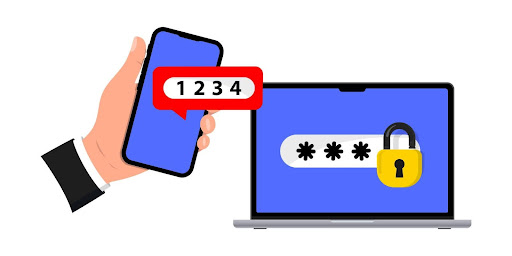As we move further into 2025, discussions regarding cybersecurity have progressed far beyond firewalls and antivirus programs. At the center of this evolution is one of the most vital elements of digital protection, Multi-Factor Authentication (MFA). Although MFA is already a conventional practice for businesses and SMBs, the development of this layer of security is now poised to revamp identity protection.
Let’s take a look at what’s next for MFA in 2025 and how upcoming trends are revolutionizing the future of identity security.
Passwordless Authentication Leads the Way
Passwords are increasingly becoming a weak point in cybersecurity. Despite a strong password policy, user error and phishing attacks compromise conventional login systems. Passwordless authentication is becoming mainstream in 2025. Biometric logins (fingerprint, facial recognition), hardware security keys, and magic link-based logins are driving this trend.
This trend is not merely about convenience; it’s a leap to more identity assurance. Companies seeking the best multifactor authentication solutions are choosing products that enable passwordless authentication, lessening reliance on user memory and decreasing credential-based attacks.
Context-Aware Authentication Becoming the Norm
Another increasing trend in 2025 is adaptive or context-aware MFA. Instead of the same degree of authentication each time, context-aware MFA examines user behavior, device, location, log-in time, and other data to figure out the degree of security required. For example, logging in via a known office machine might not need the same degree of validation as entering a dashboard via an unfamiliar network at 2 AM.
This dynamic reaction enhances both usability and security, which makes it one of the most important focuses in the best multifactor authentication solutions today.
MFA for Machine Identities and APIs
Historically, MFA was intended for human users. However, with the increasing number of IoT devices, cloud-native applications, and distributed microservices, machine identities like APIs, bots, and devices also need to be securely authenticated. Enterprises are implementing MFA protocols at the API level so that machines, just like users, are authenticated to be who they are.
Against this backdrop, solution vendors are broadening their offerings to provide secure access management for human and machine identities, enable easy API authentication, and enhance overall infrastructure resilience.
Integration with Unified Endpoint and Access Management
By 2025, MFA is no longer working in a silo. It is becoming more and more part of Unified Endpoint Management (UEM) and Identity and Access Management (IAM) tools. This makes sure that authentication processes are not only secure but also manageable through a centralized platform.
For example, Acceron’s portfolio boasts Nexus Authentication, a strong product that offers certificate-based logins, smart cards, and biometric functionality. It also seamlessly integrates with access control systems to produce a unified security environment. These integrations do more than simply layer identity security, however; they make it streamlined and efficient as well.
MFA-as-a-Service: Scalability for SMBs
MFA was previously regarded as an enterprise feature only because of cost and complexity. However, in 2025, MFA-as-a-Service (MFAaaS) is empowering small and medium-sized businesses to scale authentication without making significant infrastructure investments. Cloud-based MFA platforms provide simple setup, API integration, and friendly user interfaces, which enable businesses of all sizes to leverage it.
Most SMBs today seek the best multifactor authentication solutions that offer cloud-native agility, role-based privileges, and compliance-ready controls—all within a predictable, month-to-month cost structure.
AI-Driven Authentication Analytics
Artificial Intelligence is significantly contributing to the development of MFA. AI-powered MFA systems, through the analysis of login activity, anomaly patterns, and device profiles, have the ability to detect threats in real-time and adapt security needs dynamically. It not only minimizes friction for authorized users but also enhances protection against identity fraud.
AI-enabled analytics also enables CISOs and IT to recognize where there are areas of authentication failure and how they can further streamline their identity strategies.
User Experience Still Matters
While security is always the number one priority, user experience (UX) continues to be at the center of MFA development. Difficulty and intrusive authentication can result in user aggravation, poor compliance, or dangerous workarounds. In 2025, there’s a big trend toward frictionless security, authentication that is robust but almost invisible.
This encompasses biometric identification, QR code sign-ins, and authentication through wearable devices, all intended to safeguard users without inconveniencing them.
Conclusion
The future of MFA in 2025 is evident: it’s smarter, more adaptive, and more consolidated than ever. From passwordless authentication and context-aware policy to machine identity management and AI-powered analytics, the identity security future is dynamic and multi-dimensional.
Organizations, particularly those in industries such as finance, healthcare, or infrastructure, cannot afford to be in the slow lane of using antiquated practices. Rather, they need to adopt a contemporary MFA strategy that meets both compliance and operational requirements.
Acceron, one of the top value-added distributors in the APAC region, is pioneering this shift. Through its strong portfolio consisting of Nexus Authentication and other cutting-edge offerings designed specifically for identity and access security, Accerton supports organizations in choosing the best multifactor authentication solutions with effortless integration and technical expertise. Through innovation, security, and scalability, Accerton continues to support enterprises in their pursuit of enhanced digital resilience.



